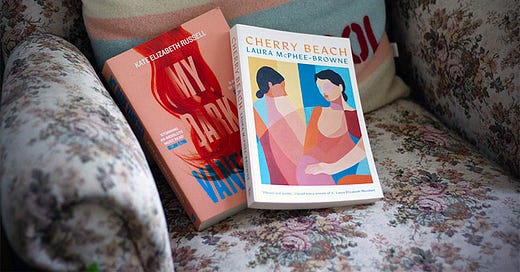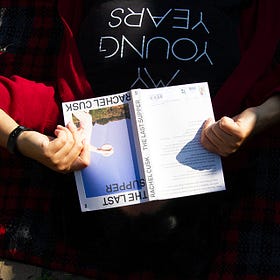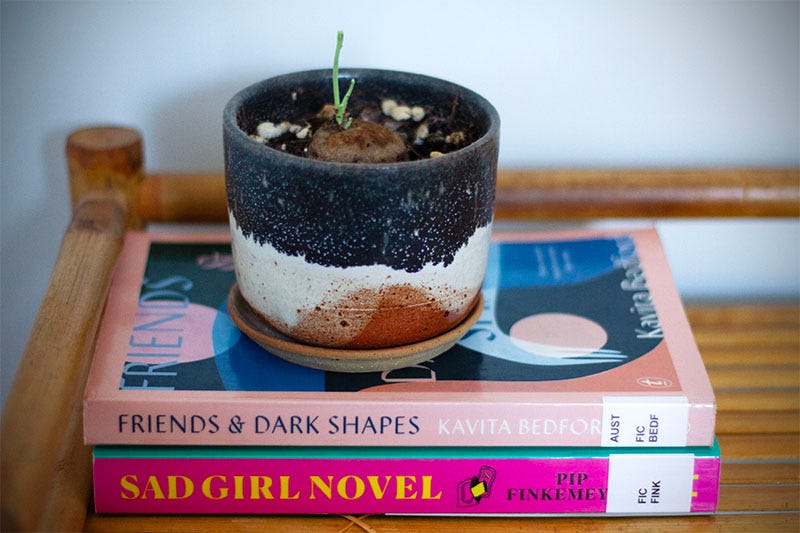10 'sad girl' novels you should actually read
Love 'em or hate 'em, they're guaranteed page turners.
Hello! I’m Celine and I write about books, cooking, gardening and surviving life in the city, when you have a wild heart. Subscribe for free posts like this one, or join the community for other exclusive writing. Either way, thanks for your support!
I’m at the tail end of moving house, a fun process which is currently eating up the majority of my free time and brain power. This week, in the interest of keeping things simple, I’m sending out two previously paywalled posts.
First up, I’m sharing the below missive from a few weeks ago, where I outline my reading rituals.
How to read more every single day
Love to read but can’t quite figure out how to embed it into your everyday life? I generally read over 100 books a year, mostly because I've managed to schedule reading into my daily life. Here are some tips and tricks, to help you achieve your own reading goals.
And for some further inspiration, I present recommended reads of a very particular genre of literary fiction… colloquially known as ‘sad girl’ novels. They’re not all bad and these are most definitely some of the best out there.
Sad girl novels. Everyone seems to either love or hate them – on this, there appears to be no middle ground.
In recent times, this sub-genre of millennial fiction has copped some slack, which I don’t find particularly fair. There is indeed, a depth to many of the novels that qualify for this moniker.
So, I’ve rounded up 10 of my favourites for your own reading pleasure.
Sad Girl Novel by Pip Finkemeyer
Sad Girl Novel is probably the most self-aware of all this list and very much owning its label. Our glum narrator in this instance is Kim Mueller, a 27-year-old Australian living in Berlin, who has given herself a year to write her very own sad girl novel. Yet, she is not writing all that much, spending most of her time obsessing over the handsome and wealthy but emotionally unavailable American literary agent Matthew.
When not busy not writing, nor obsessing over Matthew, she’s meeting with her therapist Debbie, or spending time with her best friend Bel, who’s expecting a child through an anonymous donor.
Finkemeyer is certainly critiquing the tropes we now expect of this sub-genre of literature but manages to turn Kim into a likeable – albeit frustrating – Main Character. Kim’s detailing of living in Berlin are also apt – summing up what it must be like to reside in what is an endlessly fascinating and frustrating city.
Green Dot by Madeleine Gray
Beyond a sharing of genre and being penned by Aussie writers, Sad Girl Novel and Green Dot share another thing in common – they’re both sardonic in nature and extremely fun to read.
I’ve raved about this book more than once before, but third time’s a charm, as they say. Hera is over-educated and under-employed, living in Sydney with her father and his dog. She gets a job as a comment moderator at a news website, where she meets British immigrant Arthur. Sparks fly, but of course there’s a kicker – Arthur’s married and won’t leave his wife.
This is unfortunately a familiar coming-of-age journey for many people in their twenties and it can be quite painful to read at times, as Hera’s heart battles against her own self-worth.
Lazy City by Rachel Connolly
You could be forgiven for saying that unlike many of the other protagonists on this list, Lazy City’s Erin has a legitimate reason to be sad.
A terrible event in London uproots her life there, causing her to flee back to her hometown of Belfast. After trying and failing to seek comfort from her mother, she accepts a live-in au pair job, having suspended her degree indefinitely. By night, she drinks heavily with her old friend Declan and escapes into the arms of her technically-ex-but-very-much-on-again-off-again boyfriend Mikey, and an American expat Matt, who she meets in a bar.
Many of the main characters in these stories exhibit a certain kind of ennui; drifting listlessly, rudderless, through a period of their lives. Often the catalyst is unclear, but Erin is clearly grieving; picking up the pieces of her life in a city whose familiarity alone brings at least some comfort. Connolly herself hails from Belfast and renders it in loving detail, so that you feel you are with Erin and Declan, drinking pint after pint in the city’s cosy pubs, before escaping into the night.
But The Girl by Jessica Zhan Mei Yu
But The Girl centres around Malaysian Australian ‘Girl’, our unnamed protagonist who is attempting to write a postcolonial novel while on an artist residency in Scotland. Alongside this, she is writing a paper on Sylvia Plath, who she has been somewhat obsessed with for quite some time. Having hard related to Plath’s The Bell Jar in her youth, she is now disturbed by the casual racism rife in the book, not dissimilar to the affronts she herself has to put up with even at the residency; consider one of her fellow residents saying, to her face: “diversity is kind of like hot now, like it’s the new trend”.
Girl is there to write, but what she does is think; about family, inter-generational trauma and her own upbringing in Australia as the daughter of migrant parents. This is one of those books where not a lot happens plot-wise, but oh boy, do you still go on a mental journey.
Search History by Amy Taylor
If sad girl novels have a prototype, Search History’s Ana is surely it. She’s white, she’s a millennial, she works at a tech start-up and has fled Perth for Melbourne, to move on from her last relationship. She meets Evan in a bar one night, and sparks fly. As par the course these days, she looks him up online… where she discovers that his ex Emily is not only gorgeous; she died over a year ago.
Evan refuses to speak about Emily, but Ana is desperate to know more. And with the history of their relationship splayed out online, ripe for interpretation, Ana buries herself into the past, haunted by Emily’s ghost as she puts her together, pixel by pixel.
Cherry Beach by Laura McPhee-Brown
Cherry Beach may end up being one of the most beautifully written books you’ll ever read. Mcphee-Brown’s debut follows two friends, Ness and Hetty, from Melbourne to Canada’s Toronto. Ness is outwardly a bit of a mess – unsure of herself and her place in the world as a queer woman, still growing into the person she will become. Hetty is beautiful and vulnerable; people are drawn to her, including Ness, who harbours complicated feelings for her old friend. I don’t want to give too much away, but Cherry Beach is dark and tragic; all while being a vivid page-turner.
Below Deck by Dylin Hardcastle
While the subject matter of Below Deck is hard to digest, the novel itself is a joy to read. Olivia is a woman very much living in a man’s world – a sailor onboard a boat, in a setting where traditionally, women have been unfairly considered bad luck.
While helping deliver a yacht from Nouméa to Auckland, the only woman in the crew, Oli experiences the worst kind of violence imaginable; out at ‘sea, where no one can hear you scream’. And although the sea is the setting for her terror, it is to the sea that she escapes again, travelling to the Southern Ocean where she begins to recover.
Hydra by Adriane Howell
In Hydra, we meet Anja, who has returned to Victoria from the very same Greek island… minus a wedding ring. In typical Sad Girl fashion, she is let go from her job (at an auction house) and escapes to the Mornington Peninsula (a coastal regional area just outside of Melbourne), purchasing a rundown shack. Interspersed with Anja’s story is a series of typewritten transcripts from the late 80s. These are reports of a military investigation, into odd and somewhat horrific discoveries on a Victorian base – right where Anja is now living.
From here, the story becomes distinctly creepy, as Anja begins to be haunted by a strange presence – or is it simply her own mind that’s unravelling?
Friends & Dark Shapes by Kavita Bedford
Some of the lingering appeal of this genre, is the fact that if you are of the same age group (millennial, female) there are the odd books that mirror your own experience. Friends & Dark Shapes is that for me. I too, am Australian-Indian and I too, lived in a sharehouse in the Sydney suburb of Redfern in my early twenties. Bedford captures a moment in time – a place deep within the throes of gentrification, but not quite there yet, which is exactly how I remember Redfern (for those not familiar with the layout of Sydney, Redfern has a long Aboriginal history but has been gentrified due to the city’s out of control housing prices and its close proximity to the city centre).
I digress. Our protagonist, once again unnamed, has recently lost her father. She is still processing this, as she moves into the Redfern sharehouse, rooming with flatmates who are all staring down their thirties; and what do they have to show for it? I’ve not read any other SGN that captures life in Sydney so well, for members of this generation. Priced out of the place you’ve always called home, unable to grow roots, working below-minimum wage jobs while you distract yourself with everything this sparkly city has to offer.
Much like Lazy City, Redfern and Sydney are major players in this story and it’s a joy to walk down its streets with our narrator in a world that is, as the title suggests, never quite clearly defined.
My Dark Vanessa by Kate Elizabeth Russell
My Dark Vanessa hits hard. We meet Vanessa in the modern day, as a 32-year-old, beaten down by life and numbing herself with drugs and alcohol. She learns of allegations against her former English teacher Strane, made by a past student in 2017, at the peak of the #MeToo movement. Through flashbacks, Vanessa reflects on her own twisted relationship with Strane, who groomed her at 15 when he himself was in his early 40s – at one point promising her ‘I’m going to ruin you’; yet Vanessa still, frustratingly cannot see the ways in which this prophecy has come to be.
She’s defensive in light of the allegations, insisting that what she had with Strane was different; it was not abuse, he was her ‘first love’. It is painful to a degree, being dragged into the teenaged mind of 15 year old Vanessa, and some of the scenes with Strane are obviously hard to read. Yet it is worth it, to stay with Vanessa as she comes to her own dark reckoning.
Phew. One thing is for certain as we conclude our list – this genre isn’t entirely one you’d turn to if you’re after a light read. If anything, our sad girl protagonists are grappling with Big Themes as they come of age – assault, rape, misogyny, the death of friends and families, a changing climate, under-employment and an overall disappointment with the state of the world and their place in it (perhaps making these books the perfect choice for a Friday Night Thriller?).
Yet they’re often well-written and compulsive to read – even though at times, they may hit a little too close to home.
Any books on this list you’ve read and loved? Or would like to read? And if you have any sad girl suggestions of your own, I’m all ears.
Have a good week and see you next Thursday. I’m looking forward to it – I have a content plan for this newsletter that stretches right to the end of the year. We’re going to explore some fun things together. I can’t wait to get writing (once I’m done with this soul-crushing move).
‘Til next we meet, stay well and well-fed.
-Celine
For more inspiration, check out the following literary listicles and roundups:
10 ‘easy’ and sometimes emotional page-turners
Most links in this missive will take you to YourBookstore.io. This very handy website allows you to shop and support independent Australian bookstores. Give your local some love, or request a copy from your nearest library.






I loved Lazy City, and everything on this list intrigues me!
I love your recs, as always! Nothing quite hits like a sad millenial girl!